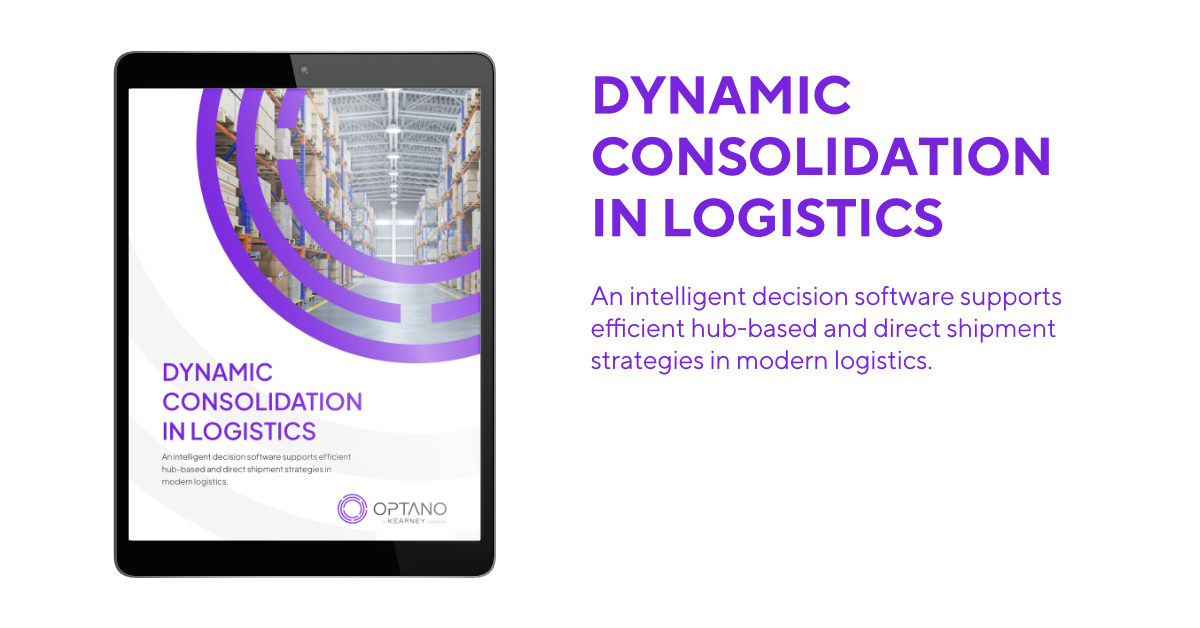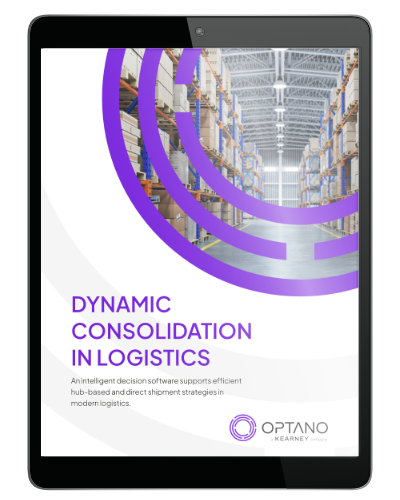SKU consolidation in consumer goods logistics
In the consumer goods industry, variety is a selling point—but it comes at a cost. Thousands of SKUs (Stock Keeping Units) fill shelves, but they also overcrowd warehouses, complicate supply chains, and drive up expenses. What may seem like customer-centricity at first glance often turns out to be a logistical challenge in practice.
The larger the product portfolio, the more complex logistics planning becomes. It’s not just about deciding which SKUs should be available where, but also how to move them efficiently through the network—from suppliers, through consolidation hubs, to distribution centers (DCs).
This is where SKU consolidation comes into play: it aims to intelligently bundle product flows, reduce transportation costs, and minimize operational complexity.
Where companies stand today—and why it’s not enough
In the logistics of consumer goods, technical wholesale, and healthcare products, thousands of SKUs must be managed daily across tightly scheduled distribution networks. The demands are increasing: shorter delivery times, volatile demand, high minimum order quantities, and rising costs.
Many companies still manage product flows based on fixed, historically grown patterns—often disconnected from current demand, lead times, or cost structures. These setups frequently rely on the hub-and-spoke model, which can appear efficient but quickly reaches its limits when conditions change.
Planning is often manual—using Excel spreadsheets, isolated ERP data, and limited transparency. This leads to inefficient transport routes, overstocked warehouses, and unnecessarily high logistics costs. Supplier-imposed minimum order quantities worsen the situation by causing excess inventory in DCs. Vehicle utilization remains suboptimal, and flexibility drops when product portfolios or demand shift.
The situation becomes especially critical during product launches, seasonal fluctuations, or sudden supply chain changes. Without an intelligent system to dynamically manage SKU flows, planning remains reactive instead of proactive.
What mathematical optimization does better
Traditional planning methods—whether manual or rule-based—cannot account for the multitude of influencing factors in modern distribution networks. They struggle to resolve complex trade-offs or adapt dynamically to change.
Mathematical optimization, on the other hand, does exactly that. It processes large volumes of data, considers constraints like minimum order quantities, lead times, and capacities, and calculates optimal decisions based on defined objectives—such as minimizing total costs or improving service levels. It enables scenario simulations, evaluates alternatives, and continuously adjusts product flows to current conditions.
This transforms rigid logistics structures into flexible, intelligent networks that can be strategically managed—within every S&OP cycle.
More interesting articles
SKU consolidation with OPTANO: agility over routine
The OPTANO solution for complex networks is a powerful software that enables companies to optimize SKU flows both strategically and operationally. Built on mathematical optimization, it integrates seamlessly into the S&OP cycle and considers all relevant parameters—from transportation and handling costs to service level requirements and network constraints.
A key advantage is the ability to simulate various consolidation scenarios. Companies can analyze which SKUs should be routed through hubs and which can be delivered directly to DCs—based on volume, urgency, cost structure, and capacity. Decisions are not only based on historical data but also incorporate future developments such as product launches or demand shifts.
Optimization is not a one-time effort—it’s continuous, typically aligned with monthly S&OP cycles. By linking master data and forecasts from ERP and planning tools, decisions are always based on up-to-date information. This enables dynamic consolidation: in each cycle, companies can flexibly decide whether SKUs should be bundled via hubs or shipped directly to target markets—for maximum efficiency and responsiveness.
OPTANO in practice:
Optimizing SKU flows in a multinational network
An international manufacturer with over 100,000 SKUs operates a complex distribution network with multiple DCs. The structure evolved over time, with SKU allocation primarily driven by storage costs, while transport effort and operational complexity were largely overlooked.
Using OPTANO, the company implemented an optimization model that realistically maps different transport modes—such as FTL (Full Truck Load) and LTL (Less Than Truck Load)—across both centralized hub structures and direct shipments from factories. The goal was to jointly minimize storage and transport costs. Analysis revealed that targeted redistribution and partial bypassing of consolidation hubs could yield significant savings.
Project results:
- 12% reduction in total logistics costs
- Improved vehicle utilization, especially for LTL shipments
- Lower inventory levels through optimized SKU allocation
- Greater transparency on cost and service level impacts of individual SKU flows
- Strategic foundation for future network planning
Intelligent consolidation is not a luxury—it’s a necessity
Modern distribution networks face increasing pressure: companies must respond faster, plan more efficiently, and reduce costs simultaneously. Traditional planning approaches fall short—they cannot reliably model minimum order quantities, volatile demand, or supplier constraints. Manual processes are error-prone and unscalable, fragmented data sources hinder holistic visibility, and without scenario simulations, decisions remain reactive.
The OPTANO solution for complex networks addresses these challenges head-on: with automated decision-making at the SKU level, integrated ERP and forecasting system connections, and powerful scenario simulation capabilities, it transforms complex networks into strategically manageable structures. Continuous integration into the S&OP cycle enables data-driven decisions and flexible consolidation in every planning round.
Intelligent consolidation becomes the foundation for efficiency, agility, and sustainable performance.
Make your network more intelligent
Looking to future-proof your logistics networks? A proof-of-concept project is an easy way to get started. Interested? Get in touch with us!

In the consumer goods industry, a diverse product range is a key selling point—but also a significant logistical challenge. Managing thousands of SKUs across complex distribution networks on a daily basis is further complicated by volatile demand, high minimum order quantities, and rising costs. Consolidating SKU-based product flows within Sales & Operations Planning has become a strategic lever for boosting efficiency and securing long-term competitiveness.
To obtain our factsheet, all you need to do is enter your contact details in the space below. A pop-up window will then open to download the whitepaper. Please note that by providing us with your email address, you agree that we may contact you on this topic. You may revoke this agreement at any time by contacting privacy@optano.com.







